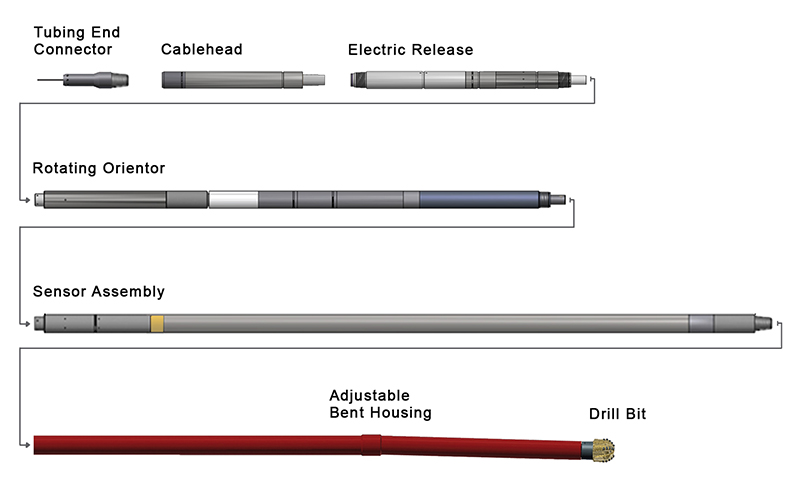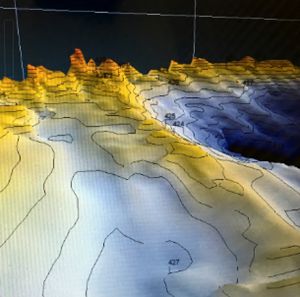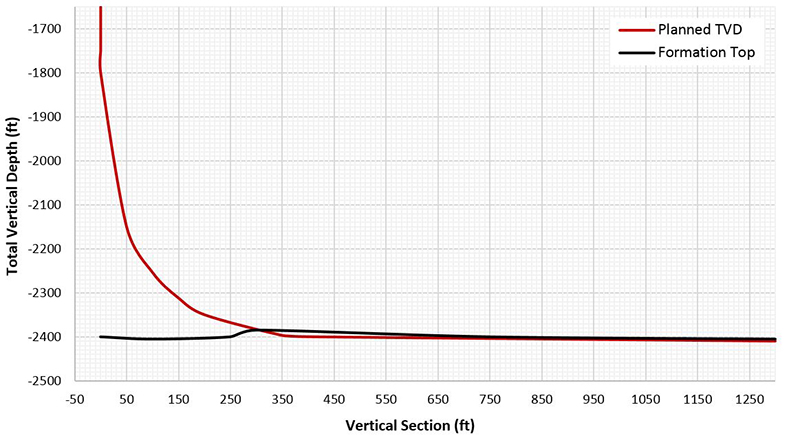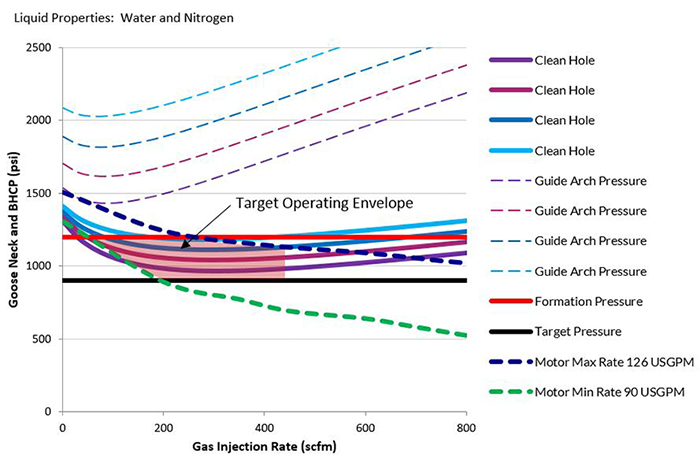The recent fall in oil price has forced operators to re-evaluate the economic viability of their reserves. Oil in the ground generates no revenue. Drilling wells and producing reservoirs profitably in a sub-$40/bbl market is one of the most significant challenges the industry has faced in many years. In this article we show how this challenge has been met with the use of innovative technology (DCTD) in a corner of the Appalachian basin.
ECONOMICALLY RE-DRILLING MARGINAL WELLS WITH UNDERBALANCED COILED TUBING DRILLING
14th April 2016
DCTD has found effective use in well-established niches in Alaska, Saudi Arabia, Russia and continental US for over 25 years. During this time, there have been substantial advances in the industry's understanding and advancement of the technology, the culmination of which is manifested in AnTech's COLT Bottom Hole Assembly (BHA).
The awareness and uptake of DCTD is increasing amongst operators, who can comprehend the significant advantages that the technology provides. The most significant benefit that DCTD can offer is the ability to drill underbalanced effectively and safely. Keeping the pressure of the wellbore lower than the pressure of the formation being drilled allows the well to produce during drilling which allows real-time evaluation of reservoir productivity as well as protecting the formation from damage. This can lead to significant improvements in productivity over wells drilled overbalanced. Other advantages of DCTD is the speed of operations from rig up to tripping time, the reduced number of personnel on site, and the smaller rig footprint.
Directional Coiled Tubing Drilling BHAs are being deployed around the world in order to drill new wells and extend previous ones by adding multi-lateral branches and extensions. More complex and larger holes of up to 8-1/2’’ are also being drilled, enabling operators to make the most of their existing reserves.

The Chosen Well
In November 2015, AnTech carried out a (DCTD) project for an independent operator in the Appalachian Basin in the North East of the United States.
An updated geological model revealed the presence of conventional oil reserves within a few hundred feet of a previously drilled dry hole. Evaluation of a project based on using Coiled Tubing to directionally drill a slim-hole side track from the dry hole revealed that the reserve could, in fact, be accessed and produced in a profitable way.
In-depth engineering and commercial studies were carried out ahead of the job on the entire lease. These studies were carried out from both a technical and commercial stand point to select the well for re-entry that would provide the greatest return on investment and was technically feasible. The bespoke financial analysis took into account the production of the well and its decline curve, as well as the costs of doing an intervention and the current oil price. By inserting the numbers into the model, it provided the operator with an accurate payback period. This analysis was performed for four candidate wells that the operator provided information for, and showed that the chosen well would give the operator the highest revenue in a shortest period of time.
The technical review was carried out using AnTech's ATLAS software. ATLAS has been developed specifically for the analysis of DCTD and was used to model tubing forces and hydraulics for a range of potential BHA and completion configurations before an optimal configuration was chosen.
It was determined that an existing dry hole would be cemented back to an identified kick off depth prior to running a 4-1/2” casing. AnTech's 3.192” COLT was chosen to exit the wellbore by kicking off from the cement plug, drilling a build to land in the reservoir and then navigating a trajectory through the relatively tight vertical constraints of the reservoir.
The reservoir in the locality is known to be susceptible to drilling fluid invasion damage, so it was decided that the entire reservoir section was to be drilled in an underbalanced condition. A mud system was designed which permitted carefully controlled amounts of Nitrogen to be injected into the drilling fluid without suspending drilling.
The Chosen Well
The COLT BHA features real time Measurement While Drilling (MWD) which, combined with a steerable motor and AnTech's patented continuously rotatable electric orientor, enables precise wellbore placement. Real-time weight and torque at the bit, coupled with real time vibration, ensures that the bit spends the maximum possible amount of time usefully engaged with the formation, minimizing specific energy used to drill the hole, and maximizing utilization of motor and bit. Real time gamma permits formation signatures to be identified as drilling progresses. The high volume of real-time data enables novel statistical techniques to be applied, resulting in increased confidence in survey data and derived positional measurements.
To complete the BHA, a 2-7/8” downhole motor with an adjustable bent housing and a 3-3/4” Polycrystalline Diamond Compact (PDC) drill bit was used. A diagram of the BHA’s modules are shown in figure 1.

Figure 1 - COLT BHA Modules
Planning & Modelling
A well path was planned that tracked approximately 15ft below the top of the reservoir and along the top of a ridge, shown in Figure 2. This would be deep enough to be sure of accessing the reservoir but not so low that it would access the oil-water contact believed to be 30ft below the reservoir top, therefore accurate depth control was critical. The maximum Dogleg Severity (DLS) of the planned wellpath was 16 deg/100 ft. This was comfortably within the capabilities of the COLT BHA which has a maximum achievable DLS of 50 deg/100 ft.

Figure 2 - The subsurface ridge identified
at the level of the target reservoir
After the detail well path, shown in figure 3 was planned, ATLAS was used to analyze the tubing forces and hydraulics. The tubing forces analysis indicated that sufficient Weight-on-Bit (WOB) could be transferred to the bit at all depths to progress the hole efficiently. It showed that a 2-3/8” coiled tubing would suffice, hence decreasing the weight onsite and easing the mobilization of the material to the wellsite.

Figure 3 - The planned well path in relation to the formation top
The ATLAS hydraulic models indicated that formation water could be used for drilling the well but would overbalance the well while drilling. To capture the advantages of underbalanced drilling required cryogenic nitrogen to be injected during the reservoir section. This analysis took into account the trajectory of the well, the casing and the hole size, as well as the formation pressure and the desired underbalance.
Figure 4 shows the predicted bottom hole circulating pressure (solid, curved lines) for a range of pump rates and nitrogen injection rates. Sufficient hole cleaning is indicated by a thick line on the graph; insufficient hole cleaning would be indicated by a thin line. It is clear to see that the hole would be sufficiently cleaned at all expected flow rates while drilling. Figure 4 also indicates the Coiled Tubing Guide arch pressures generated at different flow rates (dashed lines). Minimizing Guide Arch Pressure is an important consideration in maximizing coiled tubing fatigue life. The flow rate limits for the 2-7/8” motor used are also plotted.

Figure 3 - BHCP versus Injection Rates for 3.192" BHA run on 2-3/8" CT
The choice of fluid handling system was led by the operator’s considerable experience in the locality. The reservoir had historically produced low levels of natural gas so fluid separation was achieved with gravity tanks and a gas buster to separate out the entrained nitrogen. Any oil that was produced was skimmed from the top of the three stage tank.
The Operation Commenced
Once the well had been prepared for the sidetrack, the DCTD associated service providers arrived on site and began rigging up. The BHA was run on approximately 10,000ft of 2-3/8” coiled tubing with a seven conductor electric wireline injected. The coiled tubing and associated equipment were trailer mounted. Using a crane, the injector and lubricators were suspended above the Blow Out Preventer (BOP) stack.
As a result of the short length of the COLT BHA - 40ft including motor and bit - it was possible for the entire assembly to be contained within the length of a 48ft lubricator. This enabled the BHA to be deployed safely and efficiently in one run from the lubricator above the BOPs. Additionally, the portability of COLT allowed the BHAs to be made up horizontally, leaving only the CT connection to be made vertically. An operational advantage of this portability is that front line and reserve BHAs can be made up, checked and calibrated off the job’s critical path, and without monopolizing critical wellsite resources.
Time drilling was used to establish a sidetrack in the cement plug. During this process, the BHA’s instrumentation gave a clear indication of the high levels of vibration to which it was exposed. This information is invaluable to the driller, who can modify the drilling parameters to minimize the vibration to prolong the life of the BHA and the bit. The near bit survey instrument gave a positive indication that the sidetrack had been successfully initiated.
While drilling the build section, two substantially productive fractures were intersected. Drilling was temporarily suspended and, with the BHA still in place, nitrogen was introduced into the fluid stream, lowering the bottom hole circulating pressure to a point where the fractures produced. This gave the operator a simple, immediate measure of the productivity of the intersected fractures. The ability to test-while-drilling, as carried out on this project, is another key advantage of DCTD operations.
While drilling the build section, a marker formation was observed on the real time gamma that came in much shallower than expected. The significance of this was that, if deeper formations followed the same trend, the planned trajectory would land much further below the target formation top than intended. It was perceived that the risk of hitting a water zone was very high and so the operator decided to reduce the sidetrack length and not drill the full horizontal section. The final section of the well was drilled at a controlled ROP whilst using samples of cuttings to determine when the reservoir had been entered. This section was also drilled underbalanced with nitrogen to minimize formation damage.
Conclusions
This Directional Coiled tubing Drilling project based in the United States demonstrated that a multi-disciplinary approach, combined with modelling analysis and team based decision making can provide significant environmental and economic rewards.
The objective was to access a bypassed oil reserve from a previously drilled dry hole. This was achieved utilizing a 3.192” COLT BHA which navigated its way along a precisely pre-planned trajectory to access identified targets. The real-time, downhole data provided the drillers with the ability to consistently adjust drilling parameters for optimal drilling performance, which was particularly useful in decreasing the time taken to sidetrack the well from a cement plug.
Based on the success of this directional coiled tubing drilling project, it is intended to extend the work with multilateral branches from the motherbore. Directional Coiled Tubing Drilling technology, including the rig and the directional BHA, was utilized successfully on this chosen well and brought many advantages that conventional rotary drilling cannot provide. Future work in this field will concentrate on capturing the advantages associated with underbalanced drilling and assessing production while drilling (i.e. testing-while-drilling).
With the increased attention on accessing existing reserves whilst minimizing operational costs, there can be no doubt that the oil and gas industry will continue to embrace Directional Coiled Tubing Drilling as a reliable and economically viable technique for unlocking the potential of mature and under-producing oilfields.
+44 1392 933 100 | +1 800-868-1562